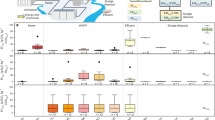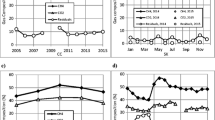Abstract
Approximately one-fifth of US households rely on septic systems for wastewater treatment. Despite their prevalence, only a handful of studies quantify greenhouse gas (GHG) emissions from residential septic systems. Recent work demonstrated that carbon dioxide (CO2) emissions from a soakaway dispersal system vary seasonally and diurnally. Similar work does not exist for other GHGs or for GHG emissions from leach field dispersal systems. This study asks the question: Do nitrous oxide (N2O), methane (CH4), and CO2 emissions from septic system leach fields vary seasonally or diurnally, and if so, do these variations impact current flux estimates? N2O emissions from the leach field were significantly greater than from control lawn for most of the summertime (June–August; p < 0.05 for all sampling dates, except mid-July p = 0.067), but dropped to a level comparable to the control lawn emissions in the fall (September–December; p > 0.05 for all sampling dates). The time of sampling also impacted CH4 and N2O emission levels. CH4 leach field emissions became significantly greater than control lawn emissions at the 22:00 sampling time (p = 0.042). N2O leach field emissions were comparable to control lawn emissions at night (p > 0.05 at all night sampling times). CO2 leach field emissions were never significantly different from control lawn emissions. These results indicate that annual emissions of N2O and CH4 from septic system leach fields cannot be calculated using one constant flux rate, as is current practice.



Similar content being viewed by others
References
Amador JA, Görres JH, Loomis GW, Lancellotti BV (2018) Nitrogen loading from onsite wastewater treatment systems in the Greater Narragansett Bay (Rhode Island, USA) Watershed: magnitude and reduction strategies. Water Air Soil Pollut 229(3):65. https://doi.org/10.1007/s11270-018-3714-4
Ambus P, Christensen S (1995) Spatial and seasonal nitrous oxide and methane fluxes in danish forest-, grassland-, and agroecosystems. J Environ Qual 24(5):993. https://doi.org/10.2134/jeq1995.00472425002400050031x
Borjesson G, Svensson BH (1997) Seasonal and diurnal methane emissions from a landfill and their regulation by methane oxidation. Waste Manag Res 15:33–54
Brannon EQ, Moseman-Valtierra SM, Lancellotti BV, Wigginton SK, Amador JA, McCaughey JC, Loomis GW (2017) Comparison of N2O emissions and gene abundances between wastewater nitrogen removal systems. J Environ Qual 46(5):931. https://doi.org/10.2134/jeq2017.03.0092
Butterbach-Bahl K, Baggs EM, Dannenmann M, Kiese R, Zechmeister-Boltenstern S (2013) Nitrous oxide emissions from soils: how well do we understand the processes and their controls? Philos Trans R Soc B 368(1621):20130122. https://doi.org/10.1098/rstb.2013.0122
Cooper JA, Loomis GW, Kalen DV, Amador JA (2015) Evaluation of water quality functions of conventional and advanced soil-based onsite wastewater treatment systems. J Environ Qual 44(3):953. https://doi.org/10.2134/jeq2014.06.0277
Diaz-Valbuena LR, Leverenz HL, Cappa CD, Tchobanoglous G, Horwath WR, Darby JL (2011) Methane, carbon dioxide, and nitrous oxide emissions from septic tank systems. Environ Sci Technol 45(7):2741–2747. https://doi.org/10.1021/es1036095
Fernández-Baca CP, Truhlar AM, Omar A-EH, Rahm BG, Walter MT, Richardson RE (2018) Methane and nitrous oxide cycling microbial communities in soils above septic leach fields: abundances with depth and correlations with net surface emissions. Sci Total Environ 640–641:429–441. https://doi.org/10.1016/j.scitotenv.2018.05.303
Geisinger D, Chartier G (2005) Managed onsite/decentralized wastewater systems as long-term solutions. Clearwaters. https://nywea.org/clearwaters/05-3-fall/ManagedOnsite.pdf. Accessed 8 Jan 2018
Groffman PM, Pouyat RV (2009) Methane uptake in urban forests and lawns. Environ Sci Technol 43(14):5229–5235. https://doi.org/10.1021/es803720h
Groffman PM, Williams CO, Pouyat RV, Band LE, Yesilonis ID (2009) Nitrate leaching and nitrous oxide flux in urban forests and grasslands. J Environ Qual 38(5):1848–1860. https://doi.org/10.2134/jeq2008.0521
Harter J, Krause H-M, Schuettler S, Ruser R, Fromme M, Scholten T et al (2014) Linking N2O emissions from biochar-amended soil to the structure and function of the N-cycling microbial community. ISME J 8(3):660. https://doi.org/10.1038/ismej.2013.160
Kinnicutt LP, Winslow CEA, Pratt RW (1910) Sewage disposal. Wiley, New York
Lancellotti BV, Loomis GW, Hoyt KP, Avizinis E, Amador JA (2017) Evaluation of nitrogen concentration in final effluent of advanced nitrogen-removal onsite wastewater treatment systems (OWTS). Water Air Soil Pollut 228(10):383. https://doi.org/10.1007/s11270-017-3558-3
Le Mer J, Roger P (2001) Production, oxidation, emission and consumption of methane by soils: a review. Eur J Soil Biol 37(1):25–50. https://doi.org/10.1016/S1164-5563(01)01067-6
Leverenz HL, Tchobanoglous G, Darby JL (2010) Evaluation of greenhouse gas emissions from septic systems. Water Environment Research Foundation. http://www.geoflow.com/wastewater/w_pdfs/WERF%20Report.pdf. Accessed 21 Sept 2018
Livesley SJ, Dougherty BJ, Smith AJ, Navaud D, Wylie LJ, Arndt SK (2010) Soil-atmosphere exchange of carbon dioxide, methane and nitrous oxide in urban garden systems: impact of irrigation, fertiliser and mulch. Urb Ecosyst 13(3):273–293. https://doi.org/10.1007/s11252-009-0119-6
Martins CSC, Nazaries L, Macdonald CA, Anderson IC, Singh BK (2015) Water availability and abundance of microbial groups are key determinants of greenhouse gas fluxes in a dryland forest ecosystem. Soil Biol Biochem 86:5–16. https://doi.org/10.1016/j.soilbio.2015.03.012
Northeast Regional Climate Center (2018) The Ithaca Climate Page. http://www.nrcc.cornell.edu/wxstation/ithaca/normal.html. Accessed 11 Jan 2018
NYS Department of Health (2012) Residential onsite wastewater treatment systems design handbook
R Core Team (2015) R: a language and environment for statistical computing. R Foundation for Statistical Computing, Vienna. https://www.R-project.org. Accessed 21 Sept 2018
Richard JT, Potts DA, Amador JA (2014) Mechanisms of ammonium transformation and loss in intermittently aerated leachfield soil. J Environ Qual 43(6):2130–2136. https://doi.org/10.2134/jeq2014.02.0046
Ryden JC, Lund LJ, Focht DD (1978) Direct in-field measurement of nitrous oxide flux from soils 1. Soil Sci Soc Am J 42(5):731. https://doi.org/10.2136/sssaj1978.03615995004200050015x
Shurpali NJ, Rannik Ü, Jokinen S, Lind S, Biasi C, Mammarella I et al (2016) Neglecting diurnal variations leads to uncertainties in terrestrial nitrous oxide emissions. Sci Rep 6:25739. https://doi.org/10.1038/srep25739
Smith KA, Thomson PE, Clayton H, Mctaggart IP, Conen F (1998) Effects of temperature, water content and nitrogen fertilisation on emissions of nitrous oxide by soils. Atmos Environ 32(19):3301–3309. https://doi.org/10.1016/S1352-2310(97)00492-5
Somlai-Haase C, Knappe J, Gill L (2017) Carbon dioxide emissions from a septic tank soakaway in a northern maritime climate. Sci Total Environ 586:485–491. https://doi.org/10.1016/j.scitotenv.2017.01.206
Truhlar AM, Rahm BG, Brooks RA, Nadeau SA, Makarsky ET, Walter MT (2016) Greenhouse gas emissions from septic systems in New York State. J Environ Qual 45(4):1153–1160. https://doi.org/10.2134/jeq2015.09.0478
United Nations Statistics Division (2016) Carbon dioxide emissions (CO2), metric tons of CO2 per capita. http://data.un.org/Data.aspx?q=Carbon+dioxide+emissions+%28per+capita%29+CFCs&d=MDG&f=seriesRowID%3a751. Accessed 11 Jan 2018
US Census Bureau (2015) American housing survey. https://www.census.gov/programs-surveys/ahs/data/interactive/ahstablecreator.html. Accessed 3 Jan 2018
USEPA (2001) Seepage pits may endanger ground water quality. https://www.epa.gov/sites/production/files/2015-06/documents/seepagepits.pdf. Accessed 15 Nov 2018
USEPA (2012) Decentralized wastewater treatment can be green and sustainable. https://www.epa.gov/sites/production/files/2015-06/documents/mou-green-paper-081712-v2.pdf. Accessed 21 Sept 2018
USEPA (2014) Annual Report 2013—decentralized wastewater program. https://www.epa.gov/sites/production/files/2015-06/documents/scb_decent_ar_2013_final-508compliant.pdf. Accessed 21 Sept 2018
USEPA (2016) Inventory of US greenhouse gas emissions and sinks: 1990–2014. https://www.epa.gov/sites/production/files/2016-04/documents/us-ghg-inventory-2016-main-text.pdf. Accessed 21 Sept 2018
USEPA (2017) Septic systems overview. USEPA. Overviews and factsheets. https://www.epa.gov/septic/septic-systems-overview. Accessed 8 Jan 2018
Wilhelm SR, Schiff SL, Cherry JA (1994) Biogeochemical evolution of domestic waste water in septic systems: 1. Conceptual Model. Gr Water 32(6):905–916. https://doi.org/10.1111/j.1745-6584.1994.tb00930.x
Winneberger JHT (1984) Septic-tank systems: a consultant’s toolkit (Vol. II. The septic tank). The Butterworth Group, Ann Arbor
Zuur A, Ieno EN, Walker N, Saveliev AA, Smith GM (2009) Mixed effects models and extensions in ecology with R. Springer, New York. http://www.springer.com/gp/book/9780387874579. Accessed 7 Sept 2017
Acknowledgements
We thank K. K. Cantilina, C. Fernandez-Baca, E. Gardner, S. K. Leung, N. R. Morse, B. G. Rahm, R. E. Richardson, Y. Seo, S. A. Sternberg, and M. Y. Szeto for their help with experimental design, fieldwork, analysis, and editing the manuscript. Special appreciation is extended to all the homeowners who volunteered to be a part of this study.
Author information
Authors and Affiliations
Corresponding author
Ethics declarations
Conflict of interest
This study was prepared for NYS WRI and the NYSDEC HREP, with support from the NYS Environmental Protection Fund, under Service Contract Number C009452.
Additional information
Editorial responsibility: Josef Trögl.
Rights and permissions
About this article
Cite this article
Truhlar, A.M., Ortega, K.L. & Walter, M.T. Seasonal and diel variation in greenhouse gas emissions from septic system leach fields. Int. J. Environ. Sci. Technol. 16, 6043–6052 (2019). https://doi.org/10.1007/s13762-019-02314-6
Received:
Revised:
Accepted:
Published:
Issue Date:
DOI: https://doi.org/10.1007/s13762-019-02314-6




